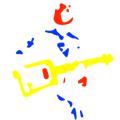Musicians need to be armed with a wide range of skills and one of the most crucial is the ability to play a wide variety of rhythmic patterns. While this will come naturally for a select few, most of us have to work at it and that's what you'll do here.
Video
2 videos, close to an hour each will have you slowly building simple rhythms, reading rhythmic notation and progressing on to complex rhythmic patterns.
Notes
All of the exercises in the workshops are notated in the workshop notes.
Listen Up
As well as exercises there are musical examples from rock, blues and New Orleans funk and second line.
Learn To Read
Musical notation is a way to represent the sounds we hear in a printed form. Deciphering these relatively simple codes is a great way to better understand just how the whole thing works. Here we're only interested in the rhyhmic aspects of the notation.
The Exercises
Over 100 rhythmic patterns cover everything from simple 4/4 patterns to complex 12/8 and 16th note patterns. You'll be finding new challenges here for years to come.
Integrated Content
Many of these rhythmic patterns are discussed in the courses and in other workshops. Breaking them down in this level of detail will reinforce what you've learned elsewhere.
